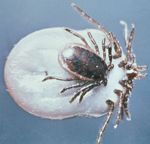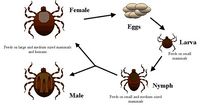Difference between revisions of "Tick Life Cycle"
m (Text replace - "Category:To_Do_-_NickJ" to "") |
|||
| Line 1: | Line 1: | ||
| − | {{ | + | {{review}} |
[[Image:Ticks mating.jpg|thumb|right|150px|''Ixodes ricinus'' mating - Wikimedia Commons]] | [[Image:Ticks mating.jpg|thumb|right|150px|''Ixodes ricinus'' mating - Wikimedia Commons]] | ||
[[Image:Ixodidae life cycle.jpg|thumb|right|200px|Life cycle of Ixodidae family ticks - CDC, Wikimedia Commons]] | [[Image:Ixodidae life cycle.jpg|thumb|right|200px|Life cycle of Ixodidae family ticks - CDC, Wikimedia Commons]] | ||
| Line 21: | Line 21: | ||
The soft ticks life cycle almost always involves multiple hosts. They feed once as larvae before moulting to become a nymph, this is followed by several more nymphal stages each involving a blood meal before moulting. Moulting takes place off the host, therefore it is common for each feed to take place on a different host. As adults the females lay multiple small batches of eggs off the host after each feed. The amount of time the soft ticks take for each blood meal is considerably shorter than that of the hard ticks and so they do not engorge to as great an extent. | The soft ticks life cycle almost always involves multiple hosts. They feed once as larvae before moulting to become a nymph, this is followed by several more nymphal stages each involving a blood meal before moulting. Moulting takes place off the host, therefore it is common for each feed to take place on a different host. As adults the females lay multiple small batches of eggs off the host after each feed. The amount of time the soft ticks take for each blood meal is considerably shorter than that of the hard ticks and so they do not engorge to as great an extent. | ||
| − | + | ==Test yourself with the Ticks Flashcards== | |
| − | |||
| − | |||
| − | |||
| + | [[Ticks_Flashcards|Ticks Flashcards]] | ||
| + | |||
| + | ==Literature Search== | ||
| + | [[File:CABI logo.jpg|left|90px]] | ||
| − | |||
| − | + | Use these links to find recent scientific publications via CAB Abstracts (log in required unless accessing from a subscribing organisation). | |
| + | <br><br><br> | ||
| + | [http://www.cabdirect.org/search.html?q=title:(%22tick%22)+AND+title:(%22life+cycle%22)&fq=subject_facet:%22Acari%22 Tick life cycle publications] | ||
Revision as of 23:28, 9 October 2010
| This article has been peer reviewed but is awaiting expert review. If you would like to help with this, please see more information about expert reviewing. |
Overview
Ticks are temporary ectoparasites meaning that they only spend a short period of their lives on the host species, the rest of the time is spent free living in the environment. Tick life cycles consist of 3 stages; larva, nymph and adult. Between each life stage the tick must take at least one blood meal in order to develop to the next stage or to produce eggs. Hard ticks take a single large blood meal at each life stage whereas soft ticks feed in smaller meals more frequently and can do so on many hosts.
Hard ticks
Hard ticks can be classified by the number of host species they parasitise during their life cycle.
One-host ticks
- These ticks will feed at each stage and develop on the same host. This group includes the genus Boophillus.
Two-host ticks
- In these species both the larvae and nymphs feed and develop on the same host. The nymphs will leave the host once they have taken a meal and develop into adults which will feed on a new host. The genus Hyalomma is an example of two host ticks.
Three-host ticks
- Each stage of the three host ticks life cycle will feed on a different host species. In general the size of the host will increase with each feed as the size of the tick increases. The Ixodes genus of ticks are three host feeders.
Soft Ticks
The soft ticks life cycle almost always involves multiple hosts. They feed once as larvae before moulting to become a nymph, this is followed by several more nymphal stages each involving a blood meal before moulting. Moulting takes place off the host, therefore it is common for each feed to take place on a different host. As adults the females lay multiple small batches of eggs off the host after each feed. The amount of time the soft ticks take for each blood meal is considerably shorter than that of the hard ticks and so they do not engorge to as great an extent.
Test yourself with the Ticks Flashcards
Literature Search
Use these links to find recent scientific publications via CAB Abstracts (log in required unless accessing from a subscribing organisation).
Tick life cycle publications


